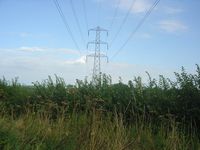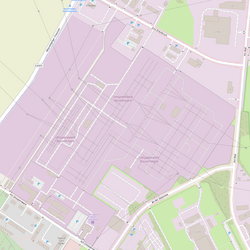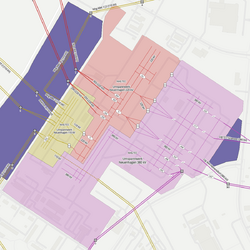Tag:power=line
 |
| Description |
|---|
| High-voltage power lines used for power transmission, usually supported by towers or pylons |
| Rendering in OSM Carto |

|
| Group: power |
| Used on these elements |
| Implies |
|
| Useful combination |
| See also |
| Status: de facto |
| Tools for this tag |
A power line or overhead line (![]() Overhead power line, IEC 466-01-02) is a structure consisting of electrical conductors carried by towers (pylons), or poles. Power line conductors are normally not coated, with the natural insulation provided by air, but may have insulation in the case of smaller lines.
Overhead power line, IEC 466-01-02) is a structure consisting of electrical conductors carried by towers (pylons), or poles. Power line conductors are normally not coated, with the natural insulation provided by air, but may have insulation in the case of smaller lines.
They are considered as line segments (IEC 601-02-31), a more general concept as to not confuse them with power=circuit. It's a portion of power conductors with common properties or construction features, modeled in OpenStreetMap as a way with corresponding tags. As soon as tagging changes, a different segment begins.
- For underground or underwater power cables, use
power=cable. - For telephone, communications, and data lines, use
communication=line.
Classification
OpenStreetMap divides power line segments into two categories: line and minor_line. This distinction helps general-purpose map renderers decide which lines are appropriate to display at each zoom level, and it's commonly ignored by specialist power data consumers. It's based on the visual prominence of the line and is inherently subjective.
As a general rule, if a line is mainly carried by towers (pylons), it's a power=line, and if it's mainly carried by smaller poles it's a power=minor_line. Some editors have a validation rule to check this, but it is common to see minor lines with occasional towers, which will cause these validation rules to generate a false positive.
Very high-voltage lines at more than 150 kV, or which form part of a ![]() transmission network, should always be tagged as
transmission network, should always be tagged as power=line.
How to map

power=line supported by a power=tower. This is a single conductor with wires=double.Draw a single ![]() way for all conductors supported by one power tower and add the tags below.
way for all conductors supported by one power tower and add the tags below.
Once drown, power line segments can optionally be involved in power=circuit or even power=line_section relations for sake of advanced power routing modeling. You will get more information about it on respective pages, on power relations or more briefly below.
You will find extensive guidelines for mapping on Power_networks/Guidelines/Power_lines.
Tagging
| Key | Value | Comment | Recommendation |
|---|---|---|---|
power |
lineminor_line |
power=line for larger lines carried on towers.power=minor_line for smaller lines.Use construction:power=line or construction:power=minor_line for power lines under construction. |
Mandatory |
voltage |
<operating voltage> | The nominal voltage at which the line is operated, in volts. May be semicolon-separated if there are multiple voltages. | Recommended |
cables |
<number> | The number of phase conductors carried by this power line. Usually a multiple of 3 (6, 9, 12). Sometimes there may be a thin earth/ground conductor - this should not be included in the number. |
Recommended |
circuits |
<number> | The number of separate electrical circuits carried by this power line. For common 3-phase systems, this is usually the number of conductors divided by 3. | Recommended |
operatoroperator:wikidata |
<line operator> | The organisation which operates the power line | Recommended |
ownerowner:wikidata |
<line owner> | The organisation that owns the power line | Optional |
wires |
single, double, triple, etc |
The number of wires which form each conductor. Often there are several individual wires per conductor bundle to increase capacity. | Optional |
name |
<name> | The name of this power line | Optional |
ref |
<reference> | The reference of this power line | Optional |
line |
bay, busbar or substation |
The function of a power line within a power=substation. |
Optional |
layer |
<number> | If power lines cross each other without connecting, a layer can be provided | Optional |
frequency |
<operating frequency> | The frequency in Hertz which the power line operates at. Not required if the line is operating at the country's normal grid frequency. May be semicolon-separated if there are multiple frequencies. | Discouraged: involve the segment in a circuit instead
|
If two lines connect in mid-air at a crossing point without any ground support, use power=connection on the node connecting them.
Lifecycle
In general, it's recommended to use lifecycle prefixes for power infrastructure, and we encourage data consumers to support these.
Power lines under construction
If a power line is under construction and is not currently operational, it should be tagged with construction:power=line (and not power=line). It's not recommended to add power lines to OpenStreetMap until construction has started on the ground.
Open Infrastructure Map shows power lines with the construction:*=* prefix.
Power lines without transit
In some cases, disused power lines may still be energised but can't support power transit. They are visually seen connected at one end and unconnected elsewhere.
Some ![]() balisors may still be up and particularly visible at night.
balisors may still be up and particularly visible at night.
If this is the case, they should be tagged as power=line.
Additionally, unconnected ends should be tagged with line_management=termination.
Disused power lines
A power line can be de-energised and not yes removed. They are visually seen as unconnected at all ends and no warnings lights are up.
It should be tagged with disused=yes, not with the disused:*=* lifecycle prefix. This is because the line is still physically present, and should be rendered on general-purpose maps which aren't expected to understand lifecycle prefixes.
Additionally, unconnected ends should be tagged with line_management=termination.
Disused power lines can't be part of any power=circuit relations.
Demolished power lines
If a power line has been removed but is still visible in common OSM aerial imagery layers, it's recommended to use the demolished:power=line lifecycle prefix so that other mappers don't re-add it. Once aerial imagery has updated, these objects should be removed - OSM is not a historical map.
Disused power lines can't be part of any power=circuit relations.
Towers and poles (supports)

power=line, not a minor_lineThe structures that support a power line should usually be tagged with ![]()
power=tower or ![]()
power=pole. Lines may also terminate on a power=portal inside a power=substation, or a power=terminal at a connection with a building.
Lines carrying multiple voltages or frequencies

power=minor_line supported by a power=pole with a transformer.If a line has multiple circuits at different voltages, they should be listed individually, separated by semicolons. For example, if there are two circuits at 66 kV and one at 33 kV, the line should be tagged as:
If there are also multiple frequencies (only in the case of HVDC or traction power), the frequency=* tag should also be semicolon separated. In this case, the frequency=* tag should have the same number of semicolon-separated items as the voltage=* tag. For example, for a line carrying 220 kV and 110 kV at 50 Hz, as well as 110 kV at 16.7 Hz for traction power:
If a power line is technically designed for another voltage than it's operated, it was suggested that this may be tagged with construction:voltage=*, however this conflicts with the meaning of construction:*=*. A formal proposal remains to be discussed to get the final solution on this topic.
However, OpenStreetMap also use power=circuit (and if necessary power=line_section) relations to model each circuit over the physical infrastructure. Particularly about frequency specification, it's now better to describe it on power circuits relations and completely remove it from the power line segment for sake of data management without redundancy.
Examples
| Picture/description | Tags | OSM Carto | Open Infrastructure Map |
|---|---|---|---|
Electricity pylon and power lines
|
power=linewires=doublecables=6circuits=2operator=(operator-name)voltage=380000
|

|

|
Three conductors correspond to one circuit (except traction power lines and high voltage direct current/HVDC). Every circuit has one voltage=* level on which it operate.
Rendering
In addition to the default OSM Carto rendering, the following maps also show power infrastructure:
- Open Infrastructure Map
- Power Grid Map
- Electricity grid map (Europe only)
- Maperitive power line rule set for rendering power lines, cables and substations in Maperitive.
See also
- Power_networks, dedicated guidelines and associated local projects.
- Classification of power lines.
- Power transmission refinement proposal
usage=transmission